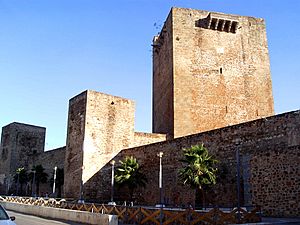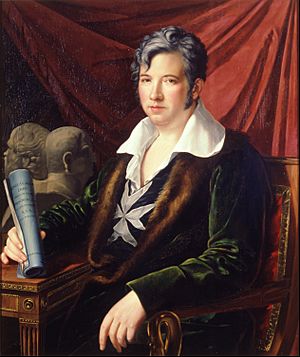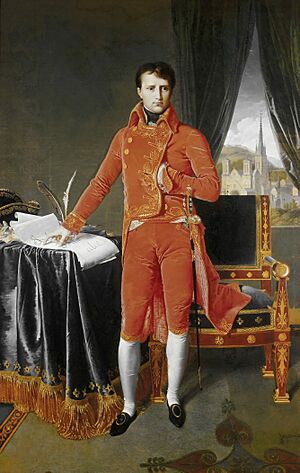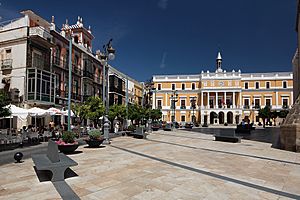Treaty of Badajoz (1801) facts for kids
| Treaty of Peace between Spain and Portugal. | |
|---|---|

Castle of Olivenza, ceded to Spain by Portugal
|
|
| Context | Portugal cedes the border town of Olivenza to Spain and closes its ports to British shipping |
| Signed | 6 June 1801 |
| Location | Badajoz, Spain |
| Negotiators |
|
| Parties | |
The Treaty of Badajoz was an important agreement signed by Spain and Portugal on June 6, 1801. This treaty meant that Portugal gave the border town of Olivenza to Spain. It also meant that Portugal had to stop British military and trade ships from using its ports.
On the very same day, Portugal signed another Treaty of Badajoz, this time with France. However, Napoleon, who was the leader of France (called the First Consul), did not agree to this version. A new, changed agreement was made in September 1801. This new treaty is known as the Treaty of Madrid. Through this, France gained large areas of Portuguese South America, which is now part of Brazil. France also received a payment of 20 million francs.
Why the Treaty Happened
For many years, Spain and France were friends. But in 1793, after the French king was executed, Spain joined other countries to fight against France. Spain lost this war and made peace with France in 1795.
Under King Charles IV, Spain's government was mostly run by a powerful minister named Manuel Godoy. The King spent most of his time hunting. Godoy decided that Spain should become friends with France again. In 1796, Spain and France formed an alliance. Spain then declared war on Britain.
Portugal also joined the fight against France at first. But unlike Spain, Portugal did not make peace with France. Portugal was in a tough spot. Napoleon wanted Portugal to stop trading with Britain to hurt Britain's economy. However, Portugal's economy relied heavily on trade with its colony, Brazil. The British navy could easily stop this trade. Britain was also the main buyer of Portugal's farm products. Because of this, Portugal wanted to stay friends with Britain. Britain sent money, supplies, and 6,000 soldiers to help Portugal.
In 1798, British troops captured the Spanish island of Menorca. Spain had fought hard to get Menorca back earlier. Losing it again made Godoy look bad. He had been removed from his top job in 1797.
British soldiers left Portugal in early 1801. Godoy then became the main minister again. In May, Spain invaded Portugal in a conflict called the War of the Oranges. The main target was the Portuguese town of Elvas. But neither side fought with much energy. When a French army came into Spain to "help," Spain and Portugal quickly agreed to stop fighting.
There was also some fighting in South America. Spain and Portugal had argued for 300 years about their borders in the Río de la Plata area. These borders were set in 1777 and 1778. But the war in Europe gave both countries a chance to try and gain more land. Spain tried to take a region called Mato Grosso in what is now Brazil, but they failed. Portugal captured an area called Misiones Orientales, which was supposed to belong to Spain. This land has been part of Brazil since 1822.
What the Treaty Said
On June 6, Spain and Portugal signed the Treaty of Badajoz. The most important parts of the treaty were:
- The town of Olivenza was given to Spain. Spain and Portugal had argued about Olivenza since 1297. Olivenza is still controlled by Spain today.
- British ships were not allowed in Portuguese ports.
On the same day, Portugal signed a second Treaty of Badajoz with France. Napoleon's younger brother, Lucien Bonaparte, signed for France. This treaty would have given France a lot of land in South America. The border between French Guiana and Brazil was set in 1713. The proposed treaty would have moved this border much further south, taking large parts of northern Brazil for France. Portugal also agreed to stop British ships from using its ports. Portugal also had to pay France 2 million francs and allow French wool products to be imported.
However, Napoleon refused to approve this treaty. He said that his brother Lucien and his foreign minister, Talleyrand, had been bribed by the Portuguese.
What Happened Next
To deal with Portugal closing its ports, Britain took over the island of Madeira in July. The Royal Navy used Madeira to gather merchant ships. These ships were then escorted safely to British ports.
However, Britain and France were already talking about peace. They signed the Treaty of Amiens in March 1802. This treaty ended the war and reopened Portuguese ports. Spain also stopped its war with Britain. There was a short break in fighting until Britain and France started fighting again in 1803.
Spain declared war on Britain again in December 1804. Portugal stayed neutral for a while. But in 1808, Spain and France signed the Treaty of Fontainebleau. This new treaty planned to divide Portugal between them. The Treaty of Badajoz had a rule that said if its terms were broken, it would no longer be valid. Portugal said that the Treaty of Fontainebleau broke the terms of the Treaty of Badajoz. This is one reason why Portugal still argues that Olivenza should belong to them. Another reason is that Spain's control of Olivenza goes against the 1815 Treaty of Vienna.
In 2003, a Portuguese politician named José Ribeiro e Castro brought up the issue of Olivenza. Even though it is still a topic of discussion, it has not caused problems between Portugal and Spain. In 2008, Olivenza and other towns became part of a special region called the Euroregion of Extrem-Alentejo.
See also
 In Spanish: Tratado de Badajoz (1801) para niños
In Spanish: Tratado de Badajoz (1801) para niños
- List of treaties
- War of the Oranges





